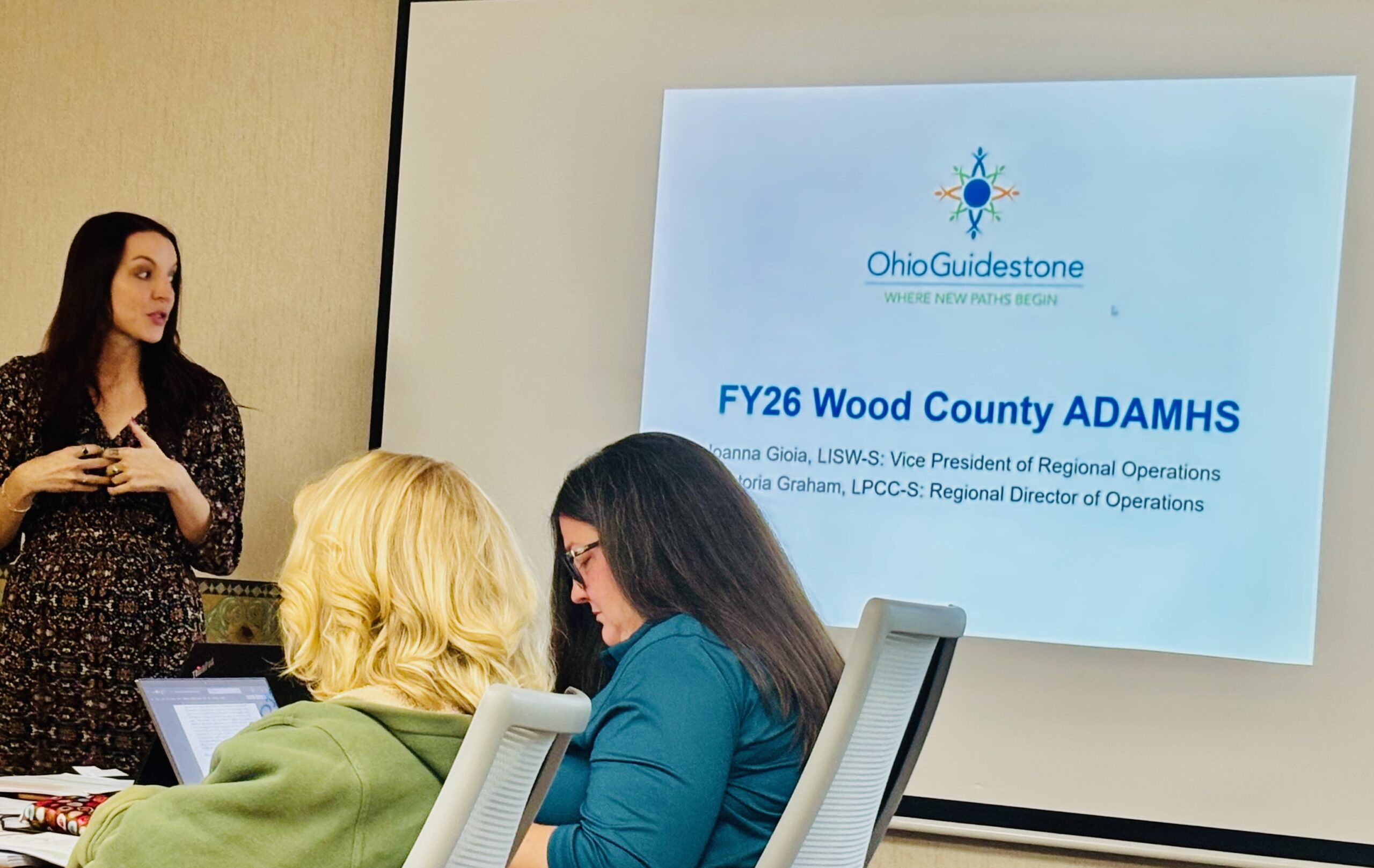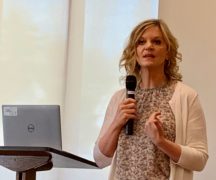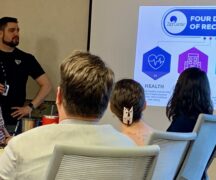By JULIE CARLE
BG Independent News
The Cocoon and OhioGuidestone outlined services and funding needs for the coming fiscal year during the recent Wood County Alcohol, Drug Addiction and Mental Health Services board meeting.
An uncertain state budget and declining state support have the county board planning an 8% cut in funds in fiscal year 2026 for the agencies it supports.
This year, the Cocoon celebrates 20 years of providing services for domestic and sexual abuse survivors in the county.
“We started solely as an emergency shelter for survivors of domestic violence, because that was the most urgent need we identified in our community,” said Cocoon Executive Director Kathy Mull. “There was no emergency shelter option in the county. And today, we have been able to double our bed size t 24 beds that are available for survivors of domestic and sexual violence.”
Services have expanded over the past 20 years to include a wide range of innovative opportunities to address the ever-changing needs in both the shelter and the community.
The shelter houses single women, single men and survivors with children and pets. “We are one of the few programs across the country that allow survivors to house their animals,” Mull said.
The agency has a full-time housing specialist dedicated to helping individuals find safe and affordable housing, whether they are leaving shelter or bypassing the shelter. There is also a full-time youth program advocate and an advocate who is housed at Bowling Green State University.
They initiated a criminal justice program in the past year to help survivors navigate the criminal justice system and an in-house medical program to provide free non-emergent medical care to survivors and their children.
The Cocoon also provides prevention and education programming in the schools, to service organizations and businesses. “Ultimately, our goal is to work ourselves out of a job. The more that we can get out and work to prevent gender-based violence from occurring, then the less likely therels going to be a need for services like ours,” Mull said.
“Today, we’re providing holistic services to survivors because we find when those services are piecemeal, that it’s much more difficult for survivors to really gain some traction in their healing process,” Mull said. “Your support continues to help us further the mission that we are here to provide,” Mull said.
WCADAMHS started funding the Cocoon when they needed matching funds to receive the Victims of Crime Act (VOCA) grant, which initially was the primary source of funding for the Cocoon. In 2018, they received approximately $600,000, which funded half of the direct service staff and operational expenses for the shelter and community funds.
Ten years ago, the Cocoon received and managed a total of six grants. Today, approximately 18 different grant-funding sources ensure the agency can provide no-cost programs and services to survivors in the county.
“This is a shift in how the government has been managing funding for programs like ours,” Mull said. “We have had to be much more diligent in finding more diversified funding sources. In fact, in 2025, we anticipate that federal, state and private grants will bring in about a million dollars to support the work we’re doing in the community.”
The VOCA funds were cut 34% in 2020, and 35% in 2021, and in 2024, they were cut an additional 10%, providing only 16% of direct service staff costs.
WCADAMHS funding ensures the Cocoon has 24/7 staffing at the shelter and for the hotline, the match for the VOCA grant, and some of the prevention services. This year’s request for the county board funds is $377,541, “to maintain our shelter operations and prevention programs,” Mull said. She also thanked the board for its help in securing some of the state’s State Opioid and Stimulus grant funding.
OhioGuidestone provides behavioral health and substance use services
The Wood County office of OhioGuidestone, based in Perrysburg, provides mental health and substance use services, along with several specialty services for Wood County residents, said Victoria Graham, OhioGuidestone regional director.
They offer mental health services for individuals with dual diagnoses (mental health and substance use) that include assessment and counseling for adults, youths and families, relational skill building for parents and guardians, therapeutic behavioral health services, and mental health psychiatry services for ages six and up.
“Generally, for the youth, they are doing more counseling and less medical, but medical evaluation is an option,” Graham said.
Substance use services include counseling, intensive outpatient relapse prevention and peer support to meet in the community or at the office to support them.
Medication-assisted treatment is available that includes methadone and other treatments.
Residential treatment and recovery housing options in Toledo and Napoleon are available to Wood County residents after the local recovery house closed earlier this year.
OhioGuidestone has a Ready-Care Clinic for walk-in behavioral health services, a Dialectical Behavior Therapy (DPT) program and an infidelity treatment program.
Project Direct Link sends staff to different jail settings to determine if the individuals meet the criteria for any types of services. OhioGuidestone provides assessments and referrals for needed services.
The WCADAMHS board has provided support to fund the program previously, Graham said. The agency also received some SOS funding.
OhioGuidestone is one of only three diagnostic clinics in the country to diagnose Fetal Alcohol Spectrum Disorder, which stems from any exposure to alcohol during pregnancy that can affect individuals, Graham explained.
“We can provide counseling to those individuals, their parents or whoever is working with them, such as guardians, teachers, caseworkers,” she said. OhioGuidestone is working with the Juvenile Residential Center of Northwest Ohio because of the incidence of FASD among residents.
WCADAMHS funds support the criminal justice programming, including the screener and half of the criminal justice liaison position. Thanks to the county board, the agency implemented the Expressive Arts program in the current fiscal year.
“The entire reason we have our expressive arts program is because you were so supportive of us being able to launch it,” Graham said. They served 38 Wood County residents ranging in age from 6 to 72, “which is pretty impressive for launching a program we had never done before.”
Because they can bill insurance for the treatment services, they are asking again for the board to support the cost of supplies, “so the clients don’t have any cost,” she said. “That can be a barrier preventing individuals from engaging.”
WCADAMHS reports declining fund balance
The agency maintains a fund balance well above what is needed to meet its reserves, reported WCADAMHS Associate Director Julie Launstein. Through 2024, there was a healthy fund balance; however, it is declining and may impact long-range forecasting of services for the county, she said.
Based on policies and procedures, the long-range forecast is required to be part of the board’s system of care budget process.
“With 2025 as projected, we are going to spend more money than we bring in, and in 2026, we will also likely spend more money than we bring in,” Launstein said.
The fund balance had increased over the years, “and then we put money aside for special projects, which was the (Unison) Crisis Stabilization Unit,” she added.
One of the issues is that the state has not provided crisis codes, which are vital to addressing urgent needs such as patients with a high risk to self or others, or significant psychological distress. If crisis codes are enacted by the state, they can ensure providers receive appropriate reimbursement for services provided during a crisis.
Though the state budget is still uncertain, if spending continues at the current rate, the agency’s fund balance will shrink below what the reserve policy allows.
“We need to make sure that we’re being very diligent in our funding of services and needing outcomes that we should meet in order to preserve our fund balance,” she said.
The situation will require some important discussions moving forward, said board chair Frank McLaughlin.
The board meets again on Monday (5/19) to review and approve contracts for fiscal year 2026.
In other business, the board:
– Adopted policies and procedures related to human resources, privacy and security.
– Approved resolutions to increase the fee for service amounts for Children’s Resource Center by $103,207; Harbor, $110,000; and Unison, $125,000.
– Agreed to continue leasing the office space in Haskins Landing for another year at a rate of $3,300 per month.
– Continued a contract with InTech to provide network, computer and systems integration consulting services for $25,000 for the next fiscal year.





